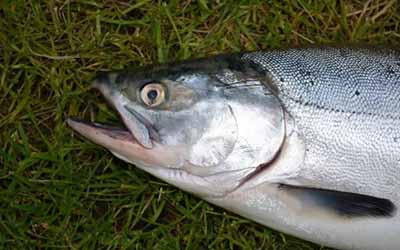Scotland’s Pink Salmon Task Group scaling up for an expected invasion of pink salmon in 2023
Scotland’s Pink Salmon Task Group is urging the public to be on the look-out for invasive, non-native pink salmon in Scotland’s rivers, as part of Invasives Species Week 2023. Pink salmon are native to the Pacific Ocean but are now appearing in Scotland’s rivers in increasing numbers. They represent a threat to the country’s unique aquatic biodiversity and freshwater fisheries.
The Pink Salmon Task Group comprises Fisheries Management Scotland, Scottish Government, NatureScot, Scottish Environment Protection Agency (SEPA), and the Dee and Ness District Salmon Fishery Boards. The group was established to monitor the extent of the pink salmon invasion and prioritise and facilitate appropriate management action. At a local level, these management measures can include targeted netting, trapping and electrofishing to remove pink salmon before they spawn. In addition, water samples will be taken from a range of Scottish rivers and analysed for the presence of pink salmon DNA in the water. This will help identify the presence of pink salmon in rivers across Scotland, including those with low angling effort.
The Pink Salmon Task Group is urging the public to report any sightings of pink salmon via a bespoke app developed by Fisheries Management Scotland.
Biodiversity Minister Lorna Slater said: “Invasive Species Week is a time where we recognise the negative impacts that non-native species can have on Scotland’s biodiversity and celebrate the action that is being taken across Scotland to address them and restore our natural environment. “We have been working closely with partner agencies to prepare for the possible return of invasive non-native pink salmon in 2023. “We have refreshed our guidance on what to do if these fish are caught or spotted in Scottish waters and have provided helpful advice for members of the public on how to report sightings.
“Our recently published Wild Salmon Strategy Implementation Plan commits to developing and improving the monitoring and mitigation strategies for future invasions of pink salmon. We will continue to work with our partners to monitor the situation and to consider future practical actions.”
Brian Davidson of Fisheries Management Scotland, commented, ” Fisheries Management Scotland is working closely with our partners to mitigate the risk of this invasive non-native species to native freshwater fish populations. We have developed specific guidance to help people identify pink salmon and take appropriate action if one is caught. By humanely dispatching pink salmon, and reporting sightings and catches using our App, the public can play a vital role in helping us understand the extent of the issue and minimizing the impact.”
Prof Colin Bean of NatureScot said, “Pink salmon are an emerging threat to freshwater biodiversity in Scotland and experience from elsewhere in Europe has shown the impacts of this invasion can be significant. Experience with other invasive species has also shown that surveillance and early action are key to successful action and we now have, in environmental DNA, a powerful tool to help us identify the arrival and distribution of these fish in our rivers. This will help relevant agencies and stakeholders to develop a programme of appropriate action.”
SEPA’s Biodiversity team manager, Dr Scot Mathieson, said: “This summer, for the first time in Scotland, the use of ground-breaking eDNA water sampling across a range of Scottish rivers will help to identify the presence of pink salmon and provide a much better understanding of where these fish are occurring in our freshwaters. This will inform future management and control.”
The app can be downloaded for free on Android and iOS devices. To locate and report a sighting of pink salmon and other non-native species, open the app and follow the simple instructions.

